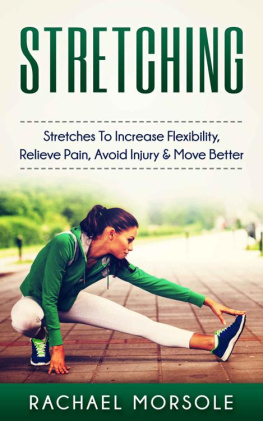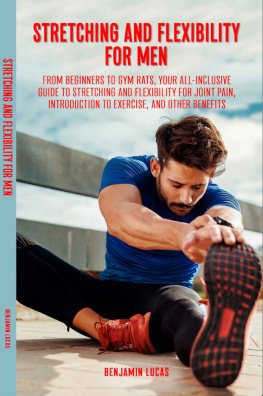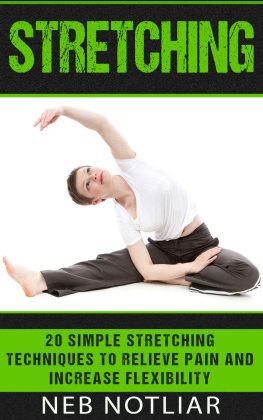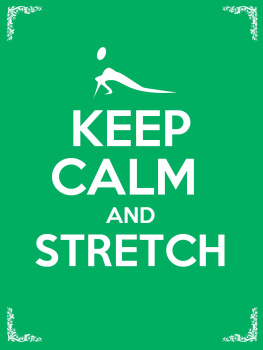Stretching plays a crucial role in not only fitness, but in your overall health. No matter who you are a professional athlete, an on-the-go businessman, a young student, or a stay-at-home parent you need to stretch.
Spending even just five minutes of your day to do some basic stretching exercises will make a world of a difference on your physical and mental wellbeing. On the other hand, not stretching at all will make you a lot more susceptible to injury and stress.
If you want to know more about stretching, such as how to do it properly, for how long you should stretch your muscles, which muscles to stretch, and so on, then this book is definitely for you!
This book is organized in such a way that you will be able to properly stretch all of your major muscle groups like a pro even if you have never tried stretching your whole life! The first two chapters are all about letting you understand more about stretching, its benefits, and the basic techniques and guidelines. The remaining chapters are filled with step-by-step instructions on how to target your upper body, core, and lower body muscles.
By the end of this book, you can bet on becoming more passionate and motivated to start stretching every single day. Maybe you will even want to do stretches in the morning and at night. So go ahead and get started right now!
Chapter 1 The Benefits of Stretching
Heres the thing: we all need to stretch every now and then. The body needs it so much that you could even feel a sense of relaxation and contentment after a stretch. Heck, you could even see the satisfaction in a dog or cats face when it stretches. And we know that, for some reason, stretching is good for us. But why?
Probably the main reason why we stretch even if we are not always aware of doing so is to help loosen up tightened muscles. Stretching as soon as you wake up in the morning, for instance, helps to make the muscles more limber after hours of being on a certain sleeping position. Likewise, a few stretches after carrying a heavy bag helps to ease the discomfort caused by the bags weight.
But what happens if we forget to stretch?
The typical lifestyle of modern-day folks can be described as fast-paced and hardwired, but terribly sedentary. We are too fixated on the screen in front of us that we tend to forget to give your bodies a break from maintaining this rigid posture for long periods of time. This leads to long-term damage on your muscles as well as your skeletal alignment. Keep in mind that as we age, the muscles naturally shorten and become tighter. In time, the range of motion in the joints becomes greatly limited and what used to be easy everyday activities become more arduous to do.
But, if we make the conscious effort to incorporate stretching exercises into our everyday routine, we are more likely to extend (no pun intended) the capabilities of our bodies.
So what are the most important benefits of stretching? You will find the answers listed below:
You become more flexible and resistant to injuries.
Flexibility is the quality of the body in terms of its ability to bend without breaking. As you stretch your muscles regularly, they become more adapted to the range of motions that you subject them to. When that happens, you are more likely to perform well in physical activities and at the same time, become less likely to experience discomfort as you work your muscles. This is because stretching minimizes the strain in the joints and sprain in the muscles since they have already been conditioned by the exercises.
You are less likely to experience sore muscles after a workout.
Whatever strenuous physical activity you engage in on a regular basis, your chances of experiencing delayed onset muscle soreness (or DOMS, for short) after it will be significantly reduced when you regularly stretch. DOMS occurs when the muscles develop microscopic tears in their fibers after they have undergone new, unfamiliar movements. However, when the muscles are trained to be more elastic through stretching, they are much less likely to get these tears.
Your mind becomes more relaxed and calmer.
Aside from benefiting your body, stretching can also benefit your mind. Unlike most other exercises such as lifting and cardio, stretching is more of a slow, calm and relaxing exercise. It enables you to relax the muscles and to follow slow, methodical movements. Also, you will notice that you will only have to focus on your breathing and the muscles you are stretching during each exercise.
As you practice stretching exercises regularly, you will be able to discover even more benefits for yourself. One of the most common responses of those who have been doing stretching exercises for a while is that they have noticed that they tend to feel less stressed throughout the day. It may be that the physiological discomfort they experience has been reduced. It may also be that the mental strain they usually experienced has lowered. However you will respond to regularly engaging in stretching exercises, it is certain that your overall quality of life will improve.
But, before you begin learning the different stretching exercises, it is important to first know about the right techniques to ensure that you will do them all effectively. You will find such information in Chapter 2.
Chapter 2 General Guidelines for Proper Stretching
Stretching is a completely personal experience. You can do it on your own, in a class or with a trainer, but all the same, the great feeling of relief during and after a stretch is completely yours to enjoy.
If you are to do stretching exercises on your own, you must first make sure that you get your doctors approval, especially if you have a medical condition. For instance, those who have osteoporosis, arthritis, or have just recovered from an injury should not engage in any form of flexibility exercise without their doctors consent. By consulting a medical professional, you will be able to gauge your limits and make adjustments to the exercises based on his or her advice.
Things to Remember Before Stretching
Once you are ready to start stretching, you can go ahead and map out a plan that will help you build the habit. To do that, there are a few details that you should keep in mind, and these are:
When to start stretching. The easiest answer to that might be anytime, but most fitness experts would recommend that you do so as soon as you wake up in the morning and/or right before you go to bed at night.
However, before you stretch, you should first warm up your muscles. This means that you should do at least 5 minutes of light cardio to boost your circulation and improve your muscles ability to become more flexible. Light cardio can be as simple as 5 minutes of jumping jacks, jogging, or even walking.
How often you should do stretching exercises. You can stretch each muscle at least once per day to help boost its flexibility. Once you can sense that the stretching exercise has become too easy, you can increase it to two or even three times per day. The least number of times you should engage in stretching exercises is three days per week. However, doing so even just once a week is still a hundred percent more than not engaging in it at all.
How long you should hold a stretch. This is probably one of the most common questions asked by those who choose to exercise at home. So here is the answer to that: 30 seconds or more. At least, that is what the experts say. According to them, if you did not hold the stretch for at least 30 seconds, your muscles would not be given enough time to lengthen and conform to the stretch.






